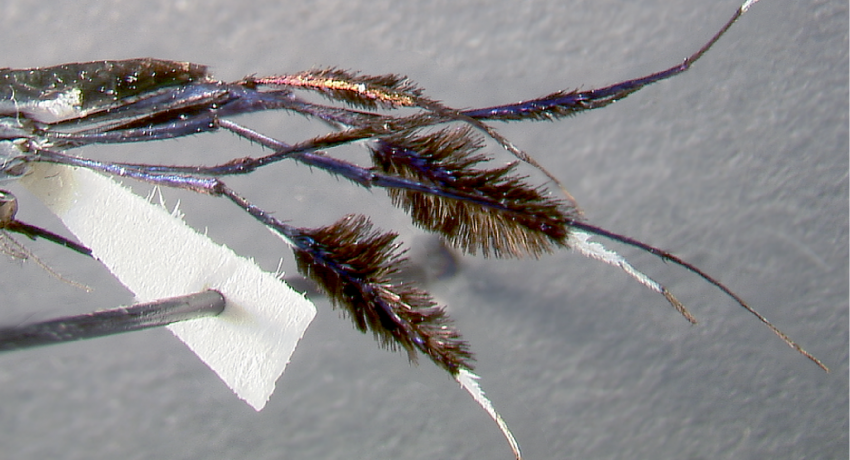NEOTROPICAL REGION
Generic abbreviation: Sa.
Type species: Sabethes locuples Robineau-Desvoidy
Etymology: not stated
Sabethes are the Hollywood showgirls of the mosquito world—with large broad multicolored pleural scales and bright metallic scales on the scutum—and are quite spectacular. The forest-associated genus comprises 41 species, subdivided into five subgenera: Davismyia (one species), Peytonulus (12 species), Sabethes (18 species), Sabethinus (six species), and Sabethoides (four species). Previously restricted to South America, two new species of subgenus Sabethinus—Sa. andreae Harbach and Sa. theresae Harbach—have recently been described from Costa Rica. The monotypic species in Davismyia—Sa. petrocchiae—is the only Sabethine outside of the genus Wyeomyia to bear prealar setae.
DIAGNOSTIC CHARACTERS (Click photos to view; mouse over and click large photo to zoom in.)
ADULT (illustrated): Thorax: Antepronotum large, nearly meeting dorsally; scutum with overlapping, broad, bright metallic colored scales; mesopostnotum well-developed; prealar setae absent; pleuron densely covered with large scales and a few setae; setae restricted to the anterior margin and posterior to wing base. Abdomen: Abdomen truncate, with a shaggy appearance on the posterior segments. Legs: Fe-I,II always longer than Fe-III; Ta-III1–5 longer than Fe-III + Ti-III combined; paddles of outstanding scales on some legs (subgenus Sabethes).
LARVA (not illustrated): Head: Maxilla (Mx) with prominent apical tooth; maxillary brush reduced and made up of individual fibers; maxillary palpus and cardo fused with the body of the maxilla.
TAXONOMIC KEYS
None
![]()
WRBU – Genera – Global – Larva
![]()
WRBU – Genera – Neotropical – Adult
![]()
WRBU – Genera – Neotropical – Larva
Exemplar DNA sequences
Sa. glaucodaemon whole mitochondrial genome: NC_037500, MF957173
Sa. chloropterus whole mitochondrial genome: NC_037499, MF957172
Sa. belisarioi whole mitochondrial genome: NC_037498, MF957171
BIONOMICS
Immatures
Sabethes immatures occupy in a wide range of natural plant containers including bamboo, leaf axils and aroids, flower bracts, palm and tree stumps, tree holes, and fallen spathes. Larvae of some species of the subgenus Sabethes—including Sa. gymnothorax and Sa. bipartipes—are predacious.
Adults
Species of the subgenus Sabethes bear distinctive plumose ornamental leg paddles, which are used in some species—including Sa. cyaneus & Sa. chloropterus—to elaborate complex courtship displays, but also appear to serve a role in mate attraction in males. In the laboratory, male Sa. chloropterus rarely approached de-paddled females, yet when de-paddled males approached females, courtship behaviors continued unhindered.
Sabethes females are generally active—mating, host-seeking and ovipositing—during the day. Species in the subgenus Sabethoides are primarily arboreal, becoming active in the late afternoon when most forest mammals rest. Sabethes (Dav.) petrocchiae have been collected biting man during the day in gallery forests in Bolivia. Subgenus Sabethes species—including Sa. amazonicus, Sa. cyaneus, and Sa. quasicyaneus—feed both in the canopy and at ground level and are attracted to people and forest mammals including primates in Peru, increasing their potential to vector zoonotic pathogens. Sabethes (Sbo.) chloropterus is a highly competent vector of yellow fever.
*Associated pathogens: This list reports bacteria, viruses, and parasites recovered from, or experimentally passed through this species, and does not imply field vector status.
IMPORTANT REFERENCES (full citations below)
Belkin 1968b: 29 (taxonomy)
Harbach 1991c (taxonomy, comparative morphology)
Judd 1996 (phylogeny)
VALID SUBGENERA
Davismyia Lane & Cerqueira [Dav.]
Peytonulus Harbach [Pey.]
Sabethes Robineau-Desvoidy [Sab.]
Sabethinus Lutz [Sbn.]
Sabethoides Theobald [Sbo.]
CURRENT GENERIC SYNONYMS
syn. Sabettus Agassiz 1846: 329 [Harbach 2018c]; Scudder 1882: 297 (unjustified emendment of Sabethes).
CITED REFERENCES
Agassiz, L. (1846). Nomenclatoris zoologici index universalis, continens nomina systematica classium, ordinum, familiarum et generum animalium omnium, tam viventium quam fossilium, secundum ordinem alphabeticum unicum disposita, adjectis homonymiis plantarum, nec non variis adnotionibus et emendationibus. Jent et Gassmann, Soloduri [= Solothrun, Switzerland], 393 pp.
Belkin, J.N. (1968b). Mosquito studies (Diptera, Culicidae). IX. The type specimens of New World mosquitoes in European museums. Contributions of the American Entomological Institute, 3(4), 1–69.
Harbach, R.E. (1991c). Ontogeny of the larval stage of Sabethes chloropterus, with special reference to setal development and phylogenetic implications for the family Culicidae (Diptera). Mosquito Systematics, 23, 10–24.
Judd, D.J. (1996). Review of the systematics and phylogenetic relationships of the Sabethini (Diptera: Culicidae). Systematic Entomology, 21(2), 129–150.
Scudder, S.H. (1882). Nomenclature Zoologicus. An alphabetical list of all generic names that have been employed by naturalists for recent and fossil animals from the earliest times to the close of the year 1879. I. Supplemental List. Bulletin of the United States National Museum, 21(19), 1–376.
CITE THIS PAGE
Walter Reed Biosystematics Unit (Year). Sabethes genus page. Walter Reed Biosystematics Unit Website, http://wrbu.si.edu/vectorspecies/genera/sabethes, accessed on [date (e.g. 03 February 2020) when you last viewed the site].






